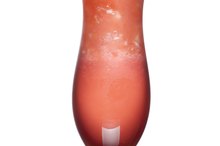What does fact checked mean?
At Healthfully, we strive to deliver objective content that is accurate and up-to-date. Our team periodically reviews articles in order to ensure content quality. The sources cited below consist of evidence from peer-reviewed journals, prominent medical organizations, academic associations, and government data.
- MayoClinic.com: Senior Health: How to Detect and Prevent Malnutrition
- National Institute on Alcohol Abuse and Alcoholism: Relationships Between Nutrition, Alcohol Use
The information contained on this site is for informational purposes only, and should not be used as a substitute for the advice of a professional health care provider. Please check with the appropriate physician regarding health questions and concerns. Although we strive to deliver accurate and up-to-date information, no guarantee to that effect is made.
Alcoholism contributes to malnutrition by decreasing appetite and vital nutrients; drinking often serves as a substitute for meals, according to MayoClinic.com 1. Many alcoholics become malnourished either because they consume too few essential nutrients or because alcohol and its metabolism prevent the body from using those nutrients, according to the National Institute on Alcohol Abuse and Alcoholism of the National Institutes of Health 2. Alcoholism results in maldigestion and malabsorption of nutrients.
Body Fat
Moderate drinkers usually consume alcohol in addition to their normal food intake, and its contribution to body fat is most evident in the central obesity commonly referred to as “beer belly.” Alcohol in heavy doses is not well metabolized and generates more heat than fat. Heavy drinkers usually consume alcohol instead of normal food intake and tend to suffer malnutrition, according to Eleanor Whitney and Sharon Rolfes in “Understanding Nutrition. 3”
Energy
Vitamins Depleted by Alcohol
Learn More
Compared to 4 calories per gram for protein and carbohydrate, alcohol contains 7 calories per gram but these empty calories are devoid of nutrients. A 12 oz. serving of regular beer provides 150 calories. A 1 ½ oz. serving of 80 proof liquor provides 100 calories and a 3 ½ oz. serving of white wine provides 70 calories. Generally, the more calories spent on alcohol, the fewer calories spent on nutritious food.
- Compared to 4 calories per gram for protein and carbohydrate, alcohol contains 7 calories per gram but these empty calories are devoid of nutrients.
- serving of white wine provides 70 calories.
Nutrients
The more alcohol people drink, the less likely they are to consume enough food to provide adequate nutrition. Nutrient deficiencies are inevitable, according to “Understanding Nutrition,” because alcohol displaces food and interferes with the body’s use of nutrients. Eventually, certain nutrients are either missing or ineffective.
Metabolism
Thiamine & Alcoholism
Learn More
Chronic alcoholism interferes with the metabolism of nutrients consumed. As an example, according to “Understanding Nutrition,” the liver loses its ability to retain the B vitamin folate so the kidneys excrete more folate in the urine and a folate deficiency that devastates the digestive system develops.
Alcohol also interferes with folate’s role in processing homocystine, so an excess level that is linked to heart disease develops. Poor folate status and alcoholism are also linked to colorectal cancer. Impairment and deficiency of another B vitamin, thiamin, results in Wernicke-Korsakoff syndrome, which affects the eye muscle, damaged nerves, impaired memory and coordination.
Acetaldehyde, produced by alcohol metabolism, also causes a vitamin B-6 deficiency which results in lower production of red blood cells.
- Chronic alcoholism interferes with the metabolism of nutrients consumed.
- Alcohol also interferes with folate’s role in processing homocystine, so an excess level that is linked to heart disease develops.
Vitamins
Alcohol contributes to malnutrition by interfering with the effective use of some vitamins. For instance, intestinal cells fail to absorb thiamin, folate and vitamin B-12. Liver cells lose the ability to effectively activate vitamin D, according to “Understanding Nutrition.”
Toxins
Direct toxic effects of alcoholism contribute to malnutrition. Alcohol causes stomach cells to secrete too much gastric acid and histamine. Histamine produces inflammation and too much gastric acid irritates the stomach and esophagus linings and makes them vulnerable to the formation of ulcers.
Related Articles
References
- MayoClinic.com: Senior Health: How to Detect and Prevent Malnutrition
- National Institute on Alcohol Abuse and Alcoholism: Relationships Between Nutrition, Alcohol Use
- “Understanding Nutrition, Ninth Edition”; Eleanor Noss Whitney and Sharon Rady Rolfes; (2002)
- Sayon-Orea C, Martinez-Gonzalez MA, Bes-Rastrollo M. Alcohol consumption and body weight: a systematic review. Nutr Rev. 2011;69(8):419-431. doi:10.1111/j.1753-4887.2011.00403.x
- Wang L, Lee IM, Manson JE, Buring JE, Sesso HD. Alcohol Consumption, Weight Gain, and Risk of Becoming Overweight in Middle-Aged and Older Women. Arch Intern Med. 2010;170(5):453-461. doi:10.1001/archinternmed.2009.527
- Tremblay A, Wouters E, Wenker M, St-Pierre S, Bouchard C, Després JP. Alcohol and a high-fat diet: a combination favoring overfeeding. Am J Clin Nutr. 1995;62(3):639-644. doi:10.1093/ajcn/62.3.639
- Tremblay A, St-Pierre S. The hyperphagic effect of a high-fat diet and alcohol intake persists after control for energy density. Am J Clin Nutr. 1996;63(4):479-482. doi:10.1093/ajcn/63.4.479
- McDonald JA, Goyal A, Terry MB. Alcohol Intake and Breast Cancer Risk: Weighing the Overall Evidence. Curr Breast Cancer Rep. 2013;5(3):208-221. doi:10.1007/s12609-013-0114-z
- Shai I, Wainstein J, Harman-Boehm I, et al. Glycemic Effects of Moderate Alcohol Intake Among Patients with Type 2 Diabetes: A Multicenter, Randomized, Clinical Intervention Trial. Diabetes Care. 2007;30(12):3011-3016. doi:10.2337/dc07-1103
- Carlsson S, Hammar N, Grill V. Alcohol consumption and type 2 diabetes: Meta-analysis of epidemiological studies indicates a U-shaped relationship. Diabetologia. 2005;48(6):1051-1054. doi:10.1007/s00125-005-1768-5
Writer Bio
Norma DeVault, a registered dietitian, has been writing health-related articles since 2006. Her articles have appeared in the "Journal of the American Dietetic Association.” She holds a Doctor of Philosophy in human environmental sciences from Oklahoma State University and a Master of Business Administration from the University of Tulsa.








